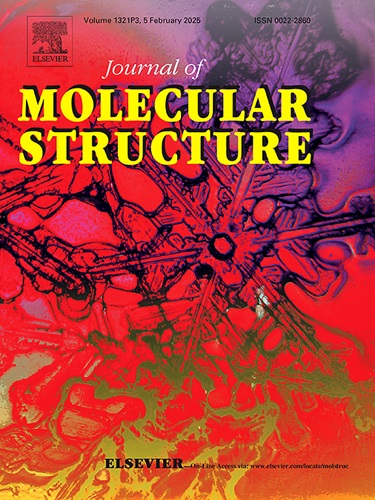铜基类fenton催化剂Cu/HAP-sBC的合成及其氧化降解水溶液中对硝基苯酚的研究
IF 4
2区 化学
Q2 CHEMISTRY, PHYSICAL
引用次数: 0
摘要
对硝基苯酚(PNP)是一种具有内分泌干扰和致癌特性的持久性酚类污染物,对水生生态系统和人类健康构成重大风险。为了解决传统Fenton工艺的局限性(如污泥产生、酸性pH依赖性),我们通过离子交换稳定和碳基质集成开发了一种新型的铜浸渍羟基磷灰石-生物炭复合催化剂(Cu/HAP-sBC)。综合表征(SEM, BET, XRD, FTIR, XPS)表明,该材料具有较高的比表面积(271.5 m2/g)和均匀的Cu分散,而hap -生物炭界面的协同作用有效地减少了金属浸出。在催化剂2.0 g/L、PNP 50 mg/L、H2O2 50 mM、pH 7.0、25℃条件下,Cu/pHAP-sBC通过吸附-催化协同作用,在60 min内对PNP的降解率达到96.41%。利用EPR和LC-MS进行的机制研究揭示了羟基自由基(·OH)驱动的逐步降解途径,涉及对硝基儿茶酚和对苯醌等中间体。本研究通过协同利用可再生生物炭和废物衍生的羟基磷灰石,开创了一种可持续的修复策略,为传统的fenton类系统去除有机污染物提供了一种无污泥、ph灵活的替代方案。本文章由计算机程序翻译,如有差异,请以英文原文为准。

Synthesis of copper-based Fenton-like catalyst (Cu/HAP-sBC) for oxidative degradation of p-nitrophenol in aqueous solution
p-Nitrophenol (PNP), a persistent phenolic pollutant with endocrine-disrupting and carcinogenic properties, poses substantial risks to aquatic ecosystems and human health. To address the limitations of conventional Fenton processes (e.g., sludge generation, acidic pH dependency), we developed a novel copper-impregnated hydroxyapatite-biochar composite catalyst (Cu/HAP-sBC) through ion-exchange stabilization and carbon matrix integration. Comprehensive characterization (SEM, BET, XRD, FTIR, XPS) demonstrated the hierarchical porous structure with a high specific surface area (271.5 m2/g) and homogeneous Cu dispersion, while the synergistic HAP-biochar interface effectively minimized metal leaching. Under optimized conditions (2.0 g/L catalyst, 50 mg/L PNP, 50 mM H2O2, pH 7.0, 25 °C), Cu/pHAP-sBC achieved 96.41 % PNP degradation within 60 min through adsorption-catalysis synergy. Mechanistic studies using EPR and LC-MS revealed hydroxyl radical (·OH)-driven stepwise degradation pathways, involving intermediates such as p-nitrocatechol and p-benzoquinone. This study pioneers a sustainable remediation strategy by synergistically utilizing renewable biochar and waste-derived hydroxyapatite, offering a sludge-free, pH-flexible alternative to traditional Fenton-like system for organic pollutant removal.
求助全文
通过发布文献求助,成功后即可免费获取论文全文。
去求助
来源期刊

Journal of Molecular Structure
化学-物理化学
CiteScore
7.10
自引率
15.80%
发文量
2384
审稿时长
45 days
期刊介绍:
The Journal of Molecular Structure is dedicated to the publication of full-length articles and review papers, providing important new structural information on all types of chemical species including:
• Stable and unstable molecules in all types of environments (vapour, molecular beam, liquid, solution, liquid crystal, solid state, matrix-isolated, surface-absorbed etc.)
• Chemical intermediates
• Molecules in excited states
• Biological molecules
• Polymers.
The methods used may include any combination of spectroscopic and non-spectroscopic techniques, for example:
• Infrared spectroscopy (mid, far, near)
• Raman spectroscopy and non-linear Raman methods (CARS, etc.)
• Electronic absorption spectroscopy
• Optical rotatory dispersion and circular dichroism
• Fluorescence and phosphorescence techniques
• Electron spectroscopies (PES, XPS), EXAFS, etc.
• Microwave spectroscopy
• Electron diffraction
• NMR and ESR spectroscopies
• Mössbauer spectroscopy
• X-ray crystallography
• Charge Density Analyses
• Computational Studies (supplementing experimental methods)
We encourage publications combining theoretical and experimental approaches. The structural insights gained by the studies should be correlated with the properties, activity and/ or reactivity of the molecule under investigation and the relevance of this molecule and its implications should be discussed.
 求助内容:
求助内容: 应助结果提醒方式:
应助结果提醒方式:


